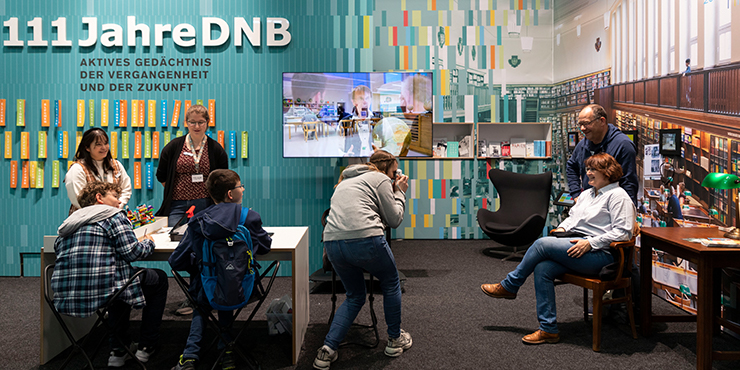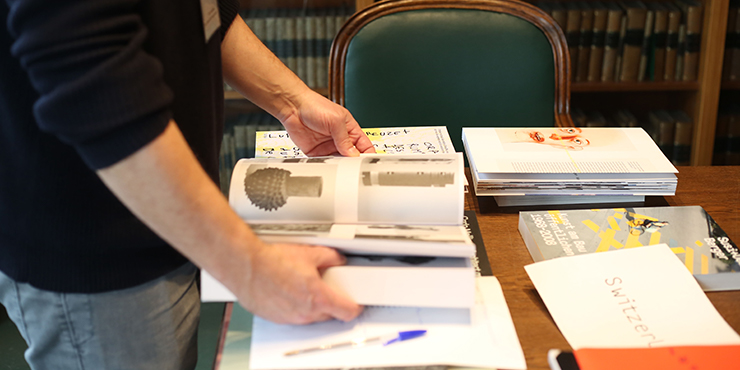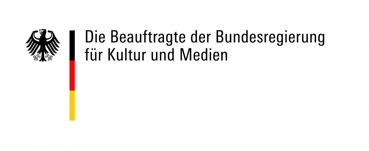6 out of 3 Million
 Photo: Stiftung Buchkunst
Photo: Stiftung Buchkunst
Contemporary witnesses: Books owned by publisher Gottfried Bermann Fischer
In the spring of 2023, the German National Library was able to reach an agreement with the heirs of publisher Gottfried Bermann Fischer regarding the return and subsequent repurchase of 20 publications. Provenance research had previously helped identify them as Nazi loot.
Gottfried Bermann Fischer (1897-1995) and his wife Brigitte Fischer (1905-1991) were the owners of S. Fischer Verlag, the publishing company founded by Samuel Fischer. Persecuted during the Nazi era for being Jewish, they moved to Vienna with their daughters in 1935. Gottfried Bermann Fischer was then able to found a new publishing company in Vienna with several parts of S. Fischer Verlag.
In March 1938, immediately after the “annexation“ of Austria, the family fled to Sweden.
Redistribution of loot
The private library which Gottfried Bermann Fischer left behind in Vienna was confiscated in 1938 and transported to the Viennese "Bücherverwertungsstelle" (book collection and distribution centre). Established by the Reich Propaganda Office in Vienna, this centre collected books confiscated from private libraries, book dealers and publishers and redistributed them among libraries in the German Reich. In all, 18 publications belonging to Bermann Fischer were sent from the Bücherverwertungsstelle in Vienna to the Deutsche Bücherei in Leipzig. Two others subsequently found their way into the present-day German National Library's collection after being purchased as antiquarian items.
Silent witnesses of their time
The bookplate, which shows two horses jumping through the initials G and B, still testifies to the origins of these two volumes. Dedications to Gottfried and Brigitte ("Tutti") Bermann Fischer also allude to the provenance of these books. Furthermore, the bundle is of interest in terms of literary and publishing history: the privately printed works in particular offer insights into the relationships between the publisher and his authors. In a few cases, the word "Secret" stamped on books by exiled authors testifies to the Deutsche Bücherei's historic censorship practices.
These volumes will remain accessible to the public in keeping with the heirs' wishes. The goal: to shed light on their eventful history of flight, confiscation and restitution. The volumes are now packed in book boxes with a DNB bookplate on the inside; this provides information about Gottfried Bermann Fischer's life story and the provenance of the books.
Protest placards by Iranian women
When Mahsa Amini, a 22-year-old Kurdish woman, died three days after her arrest in the autumn of 2022, protests broke out all over Iran and in many parts of the world. #WomanLifeFreedom has become the movement's battle cry. The organisation Iranian Women of Graphic Design is siding with the protest movement by collecting posters by Iranian female designers to raise international awareness of the protest and support the courageous demonstrators.
The platform was established in the autumn of 2020 as an attempt to counter the low visibility and representation of female graphic designers in Iran's government-regulated cultural sector. The idea was born after a book titled "100 Years of Iranian Graphic Design History" was published in Tehran. This book contained works by 100 designers – only five of whom were women. After Mahsa Amini's death, the platform was flooded with works created in support of the #WomanLifeFreedom movement.
As the number of published protest placards grew, so did the international attention they garnered, with the result that the initiative has now become a global social media movement which also features protest placards on the issue of women's rights created by female designers from all over the world. There are now more than 700 works by over 150 female graphic designers worldwide.
"Woman, life, freedom"
Which themes do the protest placards focus on? Many of them show women cutting off their hair – in Persian tradition, this is a symbol of protest and grief. Another theme is the burning hijab: during the current protests, many women removed their hijabs and burnt them on the streets as a symbol of liberation from the suppression of the patriarchal Islamic government.
Almost all of the placards feature the slogan "Woman, Life, Freedom", which was first used by Kurdish women fighting the Islamic state. Overall, the placards capture the attention with their strong visual impact, innovative designs and the topical nature of their subjects.
In 2023, the DBSM marked International Women's Day by featuring the placards in a showcase exhibition and adding them – both analogue and digital – to its collection.
The Best German Book Design: the Stiftung Buchkunst at the German Museum of Books and Writing
"The Best German Book Design" and "The Best Book Design from all over the World": the Stiftung Buchkunst has been holding competitions in each of these categories since 1963. Every year, the entries submitted are added to the holdings of the German Museum of Books and Writing (DBSM). These total approx. 600 titles a year – a simply inexhaustible repository of knowledge on the subject of books, both national and international.
The foundation's predecessor institutions have also handed their holdings over to the DBSM since the former was established in the 1920s. This means that almost 100 years of book design, book art and font design, each qualified by an expert jury, are preserved in the DBSM's stacks. In 1990, the DBSM's role as a central archive of international book art was contractually secured. The collection, which began in 1927 with the acquisition of 47 prints from the International Book Art Exhibition and had grown to no less than 1,228 items by 1938, now contains approx. 28,000 media units.
Printed books: reading with all the senses
In recent years, items from the provenance of Stiftung Buchkunst have been increasingly in demand by researchers. This is certainly due not least to the universal availability of digital texts: well-designed, hard-wearing books designed with reader ergonomics in mind are enjoying a renaissance. After years of digital euphoria and "one size fits all", the relationship between printed and digital text finally appears to be stabilising.
Once again, diverse reading needs are increasingly being considered from the perspective of reading psychology, behavioural research and sensory criteria. The collections of the book art foundations are a unique resource for researchers working in areas that range from reading research and the history of typography and design to sociological studies of reading requirements and technical implementation scenarios.
“Time Capsule”: Collecting the book fair 2023
The German Museum of Books and Writing (DBSM) is a scientific documentation centre dedicated to the history of books, publishing and media. With regard to the history of the book trade, the present is documented as well as the past: in 2023, the DBSM collected and archived items testifying to the current position of the Leipzig Book Fair within a given time window. This formed part of a three-semester seminar programme at HWTK University of Applied Sciences.
The result: a "time capsule" which also harvested the digital side of the Book Fair as comprehensively as possible. The collection encompasses all the materials issued by the exhibiting publishers and institutions – both printed and digital – as well as selected publications from the extensive supporting programme. These include invitations, flyers, posters, brochures, stickers, bags, pens, giveaways, website, electronic services, blogs, social media etc.
Collecting at record speed
Collecting under extreme pressure – the collection had to be completed in four days – and in "real time" means consciously accepting a lack of clarity and putting a pragmatic spin on the concept of completeness. Records of the methods and instruments used to collect the items are therefore vitally important. These will help future researchers understand what was collected (and what was not), to what extent and for what reason.
Digital revolution in our times
The incentive for collecting this time capsule is twofold. Firstly, to be able to look back: if our forefathers had not collected their present day, the DBSM would not now be the proud owner of the most extensive collection of trade fair catalogues in Germany, to mention just one example. The second reason for collecting the time capsule is to help the researcher of 2123, who will want tangible information on how the book, reading and information market developed during the digital revolution at the beginning of the 21st century.
There is probably no better way to assess the state of the industry and record it more tangibly than with the paper and digital promotional trappings that flood the exhibition centres every year. It is this deluge of marketing material that gives a face to the statistics collected by the Börsenverein every year.
With around 1400 exhibitors and 100 events selected from the "Leipzig Reads" programme, the collection fills several dozen metres of shelving..
 The book fair condensed: students have documented several dozen metres of shelving in cooperation with the German Museum of Books and Writing
Photo: Ramon Voges
The book fair condensed: students have documented several dozen metres of shelving in cooperation with the German Museum of Books and Writing
Photo: Ramon Voges
Between persecution and creativity – painter Karl Schwesig
The estate of writings left by painter Karl Schwesig (1898 – 1955) is now housed in the Exile Archive. Born in Gelsenkirchen on 19 June 1898, Schwesig was a politically active artist, member of the artists' initiative "Das Junge Rheinland" ("Young Rhineland") and a co-founder of the "Rheinische Sezession" ("Rhenish Secession"). His written estate bears impressive testimony to a life story dominated by persecution, maltreatment and emigration.
Schwesig came under Nazi scrutiny early on. In July 1933, he was arrested, interrogated and severely maltreated in the notorious "Schlegelkeller" in Düsseldorf. Schwesig came under Nazi scrutiny early on. He recorded his experiences in handwritten notes, which now form part of his estate. Schwesig also confronted the torture he had suffered at the hands of the SA in his 48-work cycle "Schlegelkeller". The originals have been lost.
After serving a 16-month sentence in Wuppertal-Bendahl prison, Schwesig managed to leave the country illegally and go to Belgium. In 1940, he was deported to France and interned in various camps. Schwesig also kept handwritten records of these experiences. In 1943, the SS transported him to Düsseldorf and imprisoned him several times, finally releasing him shortly before the war ended.
A moving insight into Schwesig's life
After 1945, Schwesig attempted to re-establish himself as an artist and was appointed to the post of teacher at the School of Visual and Applied Arts in Dortmund. However, his artistic preoccupation with the National Socialist dictatorship met with little interest during the post-war years. All attempts to have his tormentors prosecuted and obtain fitting reparation were in vain. Karl Schwesig died on 19 June 1955.
Along with autobiographical notes, the written estate in the Exile Archive includes documents and correspondence with persons such as Upton Sinclair, who had been trying to get Schwesig's work "Schlegelkeller" published. Other items include photographs and sketchbooks containing more than forty ink and pencil drawings offering a moving insight into the life and work of this remarkable artist.
Spy and sciences journalist – the life of Paul Rosbaud
New documents in the German Exile Archive shed light on the life of spy, chemist and science journalist Paul Rosbaud (1896 – 1963). This outstanding collection has been donated to the Exile Archive from family property. The new material will enable researchers to investigate Rosbaud's life and work and his role in the anti-Nazi resistance movement in greater detail.
Paul Rosbaud was born in Graz in 1896 and studied chemistry in Darmstadt and Berlin. Rosbaud counted renowned scientists such as Lise Meitner, Otto Hahn and Wolfgang Pauli among his friends. Rosbaud used his influence in many ways, e.g. to help Lise Meitner and geochemist Viktor Moritz Goldschmidt emigrate from Nazi Germany. . In 1939, he played a pivotal role in disseminating Otto Hahn's findings on nuclear fission – thus bringing the Nazi nuclear research programme to the public eye all over the world. A number of stories have been woven around Rosbaud's activities as a spy. He is said to have forwarded information about military and scientific plans to MI6 via the Netherlands and Norway.
Correspondence with Nobel Prize laureates
The new collection in the German Exile Archive contains manuscripts by Paul Rosbaud, including surviving fragments of memoirs and an extensive bundle of photographs taken in both private and professional settings. Particularly worthy of note are 141 letters from physicist and Nobel Prize laureate Wolfgang Pauli, dating from 1952 to 1958. 25 letters from the chemist and nuclear scientist Otto Hahn dating from 1942 to 1960, 33 letters from the physicist and Nobel Prize laureate Max von Laue dating from 1942 to 1959. Moreover, the donation encompasses a number of family documents, including correspondence with his brother, the conductor, composer and pianist Hans Rosbaud.
This unique donation is particularly significant since Rosbaud did not leave a conjoined estate and the files held by the British intelligence organisation MI6 are not yet available to the public.
Last changes:
04.06.2024










